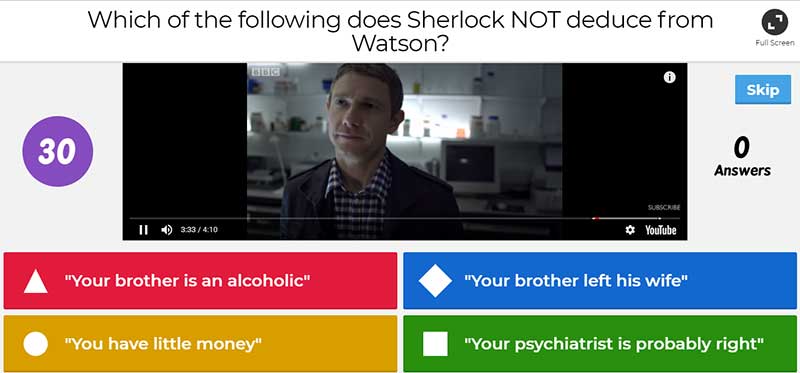Listening comprehension exercises in books usually test general understanding once students have heard the recording once and detailed understanding once they have heard it twice. Students can read the questions before the recording is played and sometimes they refuse to just listen to the audio or watch the video and focus on the questions from the very beginning.
Using Kahoot to test listening comprehension may be an alternative worth considering, as students do not necessarily know that they are going to be tested on aspects of a recording. We can choose whether students play Kahoot individually or in teams.
Having students play in teams is probably the best choice, as they can help each other recall the required information, thus learning while being tested.
Most of the times, we’ll play a recording and then we’ll run a Kahoot test with multiple-choice or true or false questions based on the statements or utterances that appeared in the recording. However, Kahoot offers several features that may enrich our test and cater for different learning styles: pictures and videos embedded in questions.
To exemplify this, we’ll see some questions based on the video “Sherlock and Watson meet”, a short excerpt from the first episode of the series “Sherlock”, broadcast by the BBC.
Prior to watching the video, students have carried out different activities to activate their schemata and to learn some key vocabulary: general discussion questions on Sherlock Holmes, picture description of rooms in 221B Baker Street, comment on the recent TV series adaptation.
After watching this clip, students play a 6-question Kahoot that contains different question types:
This is not testing listening comprehension, but vocabulary. If students do not know it, the screenshot helps them understand and memorize the word they learn and the focus and motivation created by the competitiveness in Kahoot guarantees they’ll pay attention to what the teacher explains about this word.
Usually students focus on facts while listening. However, names of characters and their relationship may be overlooked. Being able to use a picture in the question screen may help students recall the scene and the name required to answer correctly.
Again, testing facts is avoided and the question requires to remember a specific expression or collocation. The “campfire moment” that Kahoot creates can greatly help students to remember the expression, as they are usually totally focused on the activity.
Another vocabulary-based question, with a screenshot from the scene where the sentence is uttered.
Again, focus on characters.
The last question is a typical multiple-choice, content-based listening comprehension question. It is particularly difficult because Sherlock speaks very fast.
As the screenshot shows, Kahoot lets us embed video and choose the start and finish point of the excerpt we want to play for a specific question. We can either choose an excerpt or play the whole video
The Kahoot quiz is available for purchase from Kahoot Marketplace.





